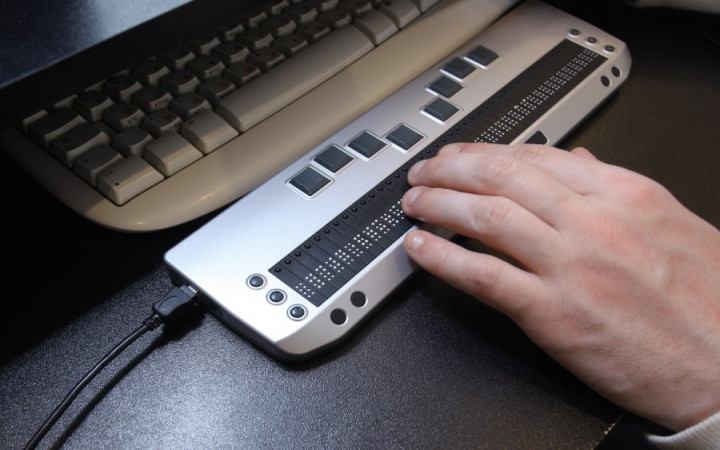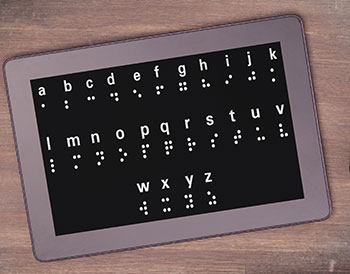OCR Devices for the Blind: Turning Print to Speech in Real-Time
Enhancing Lives With Advanced Assistive Devices for the Blind
The combination of advanced assistive tools for the blind is transforming how people experience their surroundings and engage with their neighborhoods. What does this advancement imply for the future of assistive technology and its duty in encouraging people?
Overview of Assistive Tools
Assistive tools for the blind include a varied series of devices and modern technologies designed to boost independence and boost the top quality of life for individuals with visual problems. These devices satisfy numerous requirements, from navigation and flexibility to interaction and everyday task monitoring.
One of the primary categories of assistive devices consists of wheelchair aids, such as white walking canes and guide pet dogs, which assist users navigate their environments securely. Electronic traveling help, equipped with sensors and audio comments, additionally play a significant role in flexibility enhancement.
Additionally, gadgets that help with day-to-day living tasks, such as adaptive kitchen area tools, Braille labels, and speaking watches, empower people to do tasks separately. Communication help, including display readers and Braille displays, facilitate accessibility to info and make it possible for people to involve effectively with the electronic world.
Additionally, low-tech services like amplifying glasses and large-print products stay crucial for several customers. Collectively, these assistive gadgets offer not only as practical tools yet additionally as important enablers of autonomy, fostering greater involvement in a globe that frequently prioritizes sighted experiences. Their combination into life is crucial for promoting inclusivity and boosting overall wellness for those with aesthetic disabilities.
Innovative Technologies being used
Technology in technology has substantially transformed the landscape of tools readily available for people with aesthetic disabilities. Among one of the most notable advancements are clever glasses incorporated with increased truth, which provide real-time navigation aid and things acknowledgment. These tools leverage advanced cams and expert system to provide auditory hints, improving the user's spatial recognition and freedom.
Additionally, mobile applications have actually become powerful resources, allowing users to determine currency, reviewed text aloud, and browse unknown settings through verbal guidelines. Devices such as Braille displays and refreshable Braille tools remain to advance, offering smooth connectivity with computer systems and smartphones, consequently improving interaction and accessibility to information.
Wearable innovation, consisting of smartwatches furnished with voice-activated functions, further empowers customers by helping with fast access to notices and alerts without requiring aesthetic interaction. Tactile maps and 3D printing are additionally obtaining traction, supplying concrete representations of areas that help in alignment and wheelchair training.
Jointly, these innovative modern technologies not only improve the lives of visually damaged people yet additionally foster better self-reliance, inclusivity, and engagement with the more comprehensive community, therefore reshaping perceptions of accessibility. (AI-powered visual aids)
Personal Stories of Empowerment
Empowerment commonly emerges from individual experiences that highlight the transformative influence of modern technology on people with aesthetic problems. Take, as an example, the story of Sarah, a young musician who regained her passion for paint through making use of a wise cane outfitted with challenge discovery. This tool not only promoted Read More Here her movement yet instilled a newly found confidence, allowing her to browse public spaces individually and seek her creative ventures.

These narratives underscore the profound impacts that progressed assistive tools can carry life. By making it possible for people to overcome barriers, technology fosters a feeling of freedom and self-worth. Such empowerment tales function as a testimony to the potential of development, highlighting just how the right devices can significantly enhance lifestyle and open doors to new possibilities for those with aesthetic problems.
Benefits of Advanced Solutions
The assimilation of sophisticated innovation into assistive devices dramatically transforms day-to-day experiences for those affected by vision loss. AI-powered visual aids. Instruments such as smart walking sticks geared up with sensors, navigating applications, and wearable technology are designed to provide real-time feedback, improving spatial awareness and decreasing the dangers linked with wheelchair.
Additionally, advanced assistive modern technologies promote social inclusion by assisting in communication and interaction. Voice-activated devices and applications allow individuals to accessibility details and involve with their environments independently, breaking barriers that formerly impeded their engagement in instructional, specialist, and social settings.
In addition, the personalization and versatility of these services satisfy the diverse requirements of individuals, consequently improving their total lifestyle. Enhanced performance, such as item acknowledgment and text-to-speech abilities, equips people with glasses for round face aesthetic problems to execute jobs that they might have when discovered testing. Ultimately, advanced assistive technologies not just improve self-reliance and safety and security yet additionally advertise dignity and self-regard, enabling individuals to lead fulfilling lives.
Future Trends in Assistive Technology
As modern technology remains to progress, the landscape of assistive gadgets for the blind is poised for exceptional improvements that will certainly further improve accessibility and self-reliance. Arising trends in assistive innovation indicate a change toward increased integration of artificial knowledge (AI) and machine knowing, making it possible for tools to adapt to private customer needs in real-time. These innovations are expected to promote more intuitive navigation systems that can recognize barriers and give audio feedback, significantly enhancing exterior mobility.
Additionally, the development of wearable technology, such as clever glasses furnished with enhanced fact, will certainly enable users to obtain contextual information concerning their environments, thus enriching their spatial recognition. Furthermore, advancements in haptic technology guarantee to develop responsive comments devices, permitting users to regard details through touch, enhancing discovering and interaction with their setting.
Telecommunication developments are also leading the way for remote help remedies, where trained professionals can supply support through video telephone calls, making sure support is easily obtainable. As these patterns unravel, the future of assistive devices for the blind will unquestionably cultivate greater autonomy, encouraging people to navigate their globe with confidence and ease.

Conclusion
The integration of advanced assistive gadgets for the blind directory stands for a considerable advancement in promoting independence and enhancing high quality of life. By utilizing cutting-edge modern technologies, these tools empower customers to navigate their settings with higher confidence and freedom. As the area continues to evolve, recurring r & d will likely generate much more sophisticated solutions, further changing the lived experiences of individuals with visual impairments and promoting a higher sense of incorporation within culture.
The assimilation of advanced assistive gadgets for the blind is changing how people experience their environments and communicate with their areas. The assimilation of innovative technology right into assistive gadgets considerably transforms everyday experiences for those impacted by vision loss.As modern technology continues to evolve, the landscape of assistive devices for the blind is poised for exceptional advancements that will further improve availability and independence. Arising patterns in assistive modern technology suggest a change towards enhanced integration of fabricated knowledge (AI) and machine learning, allowing gadgets to adapt to private customer requires in real-time.The combination of advanced assistive devices for the blind represents a substantial innovation in cultivating freedom and boosting high quality of life.